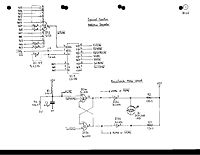Difference between revisions of "Sideways ram"
m (New page: The Sideways RAM unit, developed by Paul Townsend, comprises 128K of static RAM and an interface to the Amstrad computers, allowing software destined for sideways ROM to be developed easil...) |
m |
||
| Line 22: | Line 22: | ||
Sideways RAM schematics: | Sideways RAM schematics: | ||
| − | |||
| − | |||
| Line 30: | Line 28: | ||
| <div class="gallerybox"><div class="thumb"><div>[[Image:SidewaysRamBoard.jpg|thumb|center|200x200px|Sideways Ram Board]]</div></div><div class="gallerytext"> | | <div class="gallerybox"><div class="thumb"><div>[[Image:SidewaysRamBoard.jpg|thumb|center|200x200px|Sideways Ram Board]]</div></div><div class="gallerytext"> | ||
Sideway RAM Board | Sideway RAM Board | ||
| − | |||
| − | |||
</div></div> | </div></div> | ||
| Line 37: | Line 33: | ||
| <div class="gallerybox"><div class="thumb"><div>[[Image:SidewaysRamSchems1.jpg|thumb|center|200x200px|Sideways Ram Schematics]]</div></div><div class="gallerytext"> | | <div class="gallerybox"><div class="thumb"><div>[[Image:SidewaysRamSchems1.jpg|thumb|center|200x200px|Sideways Ram Schematics]]</div></div><div class="gallerytext"> | ||
Sideways Ram Schematics | Sideways Ram Schematics | ||
| − | |||
| − | |||
</div></div> | </div></div> | ||
| Line 44: | Line 38: | ||
| <div class="gallerybox"><div class="thumb"><div>[[Image:SidewaysRamSchems2.jpg|thumb|center|200x200px|Sideways Ram Schematics]]</div></div><div class="gallerytext"> | | <div class="gallerybox"><div class="thumb"><div>[[Image:SidewaysRamSchems2.jpg|thumb|center|200x200px|Sideways Ram Schematics]]</div></div><div class="gallerytext"> | ||
Sideways Ram Schematics | Sideways Ram Schematics | ||
| − | |||
| − | |||
</div></div> | </div></div> | ||
| Line 51: | Line 43: | ||
| <div class="gallerybox"><div class="thumb"><div>[[Image:SidewaysRamSchems3.jpg|thumb|center|200x200px|Sideways Ram Schematics]]</div></div><div class="gallerytext"> | | <div class="gallerybox"><div class="thumb"><div>[[Image:SidewaysRamSchems3.jpg|thumb|center|200x200px|Sideways Ram Schematics]]</div></div><div class="gallerytext"> | ||
Sideways Ram Schematics | Sideways Ram Schematics | ||
| − | |||
| − | |||
</div></div> | </div></div> | ||
| Line 58: | Line 48: | ||
| <div class="gallerybox"><div class="thumb"><div>[[Image:SidewaysRamSchems4.jpg|thumb|center|200x200px|Sideways Ram Schematics]]</div></div><div class="gallerytext"> | | <div class="gallerybox"><div class="thumb"><div>[[Image:SidewaysRamSchems4.jpg|thumb|center|200x200px|Sideways Ram Schematics]]</div></div><div class="gallerytext"> | ||
Sideways Ram Schematics | Sideways Ram Schematics | ||
| − | |||
| − | |||
</div></div> | </div></div> | ||
| Line 65: | Line 53: | ||
| <div class="gallerybox"><div class="thumb"><div>[[Image:SidewaysRamSchems5.jpg|thumb|center|200x200px|Sideways Ram Schematics]]</div></div><div class="gallerytext"> | | <div class="gallerybox"><div class="thumb"><div>[[Image:SidewaysRamSchems5.jpg|thumb|center|200x200px|Sideways Ram Schematics]]</div></div><div class="gallerytext"> | ||
Sideways Ram Schematics | Sideways Ram Schematics | ||
| − | |||
| − | |||
</div></div> | </div></div> | ||
|} | |} | ||
| + | |||
| + | Sideways Ram Manual: | ||
Revision as of 12:43, 19 April 2009
The Sideways RAM unit, developed by Paul Townsend, comprises 128K of static RAM and an interface to the Amstrad computers, allowing software destined for sideways ROM to be developed easily.
It wasn't so much "bought" as a workable unit, but was designed and built by Paul himself, inspired by the scrapping of the original RAM board. The interface logic between the CPC and the original RAM chips, was all his own design.
Essentially it was a "soft" version of an 8-chip ROM board, a development aid for ROM-based software. At the time Paul was developing a ROM-based word processor for the CPC. Not having PROM burning facilities at home, this unit was ideal because new versions could be assembled, tested, debugged and developed further while reproducing the target architecture.
In the end, it proved more reliable than a true ROM board since there were no hardware contacts to go haywire (though there were software bugs). Paul ended up using that exclusively, loading up a standard configuration into the sideways RAM with different ROMs, along with Maxam and Utopia, with Oddjob, BCPL, Toolkit and a few others to hand if required.
Downloads
Sideways RAM schematics:
|
|
|
|
|
|
Sideways Ram Manual:





